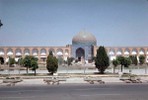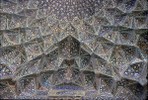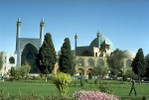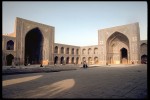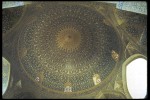Previous Lecture | Next Lecture
Concepts
The Safavids (1501-1732): Of an obscure origin which is most probably Sunni and Kurdish, the Safavids (named after a sufi master, Shaykh Safi) forged for themselves an illustrious genealogy that goes back to 'Ali, and proceeded to forcibly change Iran into a Shiite state. In the process they shaped the modern image of the Iranian nation.
Shah Abbas I (1588-1629): The greatest Safavid monarch, he moved the capital to Isfahan in 1598, and built there a royal city that extended to the south of the old city and connected it with the Zayandeh river via a wide avenue, the Chahar Bagh (Four Gardens) Avenue. Shah Abbas's royal buildings were organized around his central Maydan or along the Chahar Bagh Avenue.
The Maydan-i-Shah: Among the largest open squares in the world (1700 by 525 ft), it was the focal point of Shah 'Abbas's plan. Its four sides were lined up with shops on two levels, and each side of the Maydan had a monumental structure in its centre.
Monuments
The Mosque of Shaykh Lutfallah
(initially Sadr Mosque) Situated in the east of the Maydan with its golden tiled dome. It was constructed for an important shaykh in 1602 and used as the private oratory of the shah and his family.
The Masjid-i-Shah
The congregational 4-iwan mosque built between 1612 and 1638 that marks the south of the Maydan with its magnificent portal flanked by two minarets and its dazzling tiled dome.

